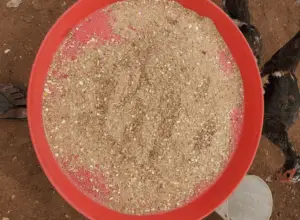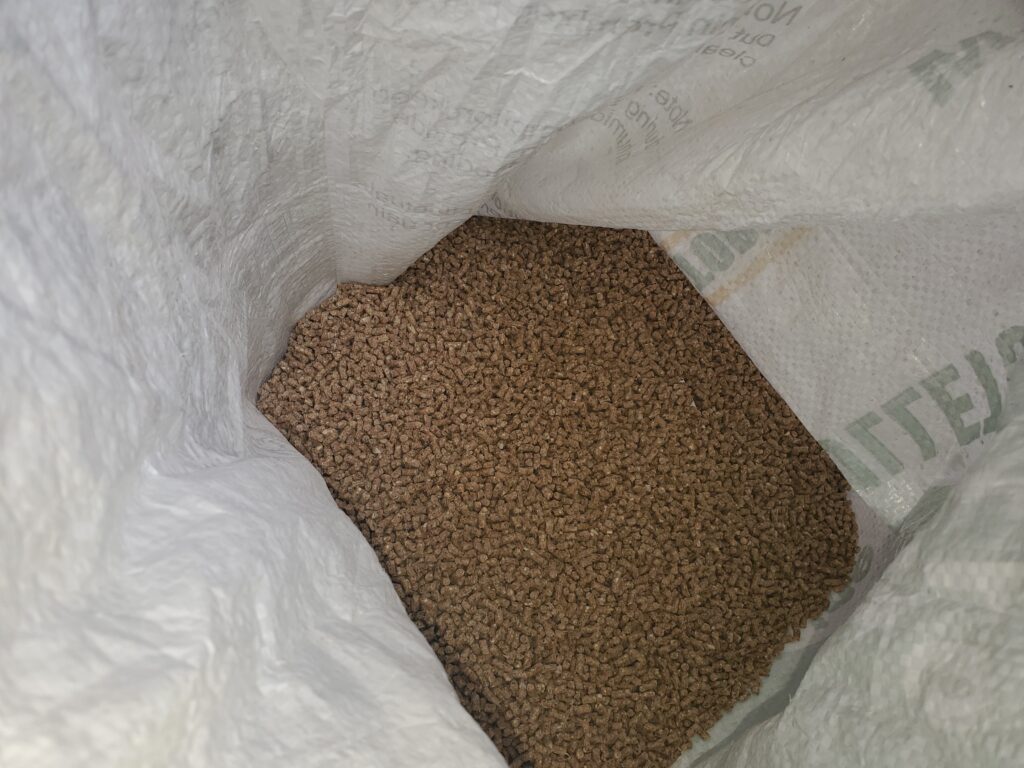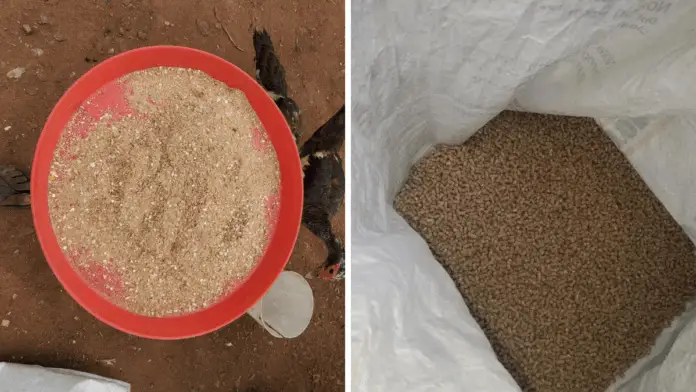Some links on this page may contain affiliate links which means that, if you choose to make a purchase using the link, Agricfy.com may earn a small commission at no extra cost to you. For more information, go to our Affiliate Disclosure Page!
Introduction
Is it better to mash or pellet your feed? This article examines the difference between mash and pellet feeds. Like many other alternatives available to broiler producers, the answer depends on a variety of circumstances.
The energy value of feed or raw materials varies depending on how they are presented. For the following feed or cereal presentation, these have been estimated:
- addition of full-grain cereals to supplementary feed
- grains or mash-form finished feed
- pelletized final feed
When given to grown birds (over 30 days of age and/or 1.2 kg in body weight), the whole cereal grain is mostly wheat, barley, sorghum (milo), and to a lesser extent, whole maize. Broken maize grain can be given to younger birds.
Regardless matter how the cereal is presented, the energy levels remain the same.
Wheat and maize are available in three different forms:
- Ground into a mash-like final feed
- Ground to make a final pelleted feed
- Complementary feed consisting of whole-grain and pellets
The energy value of wheat remains constant regardless of how it is presented. On the other hand, whole grain maize has a 3% lower value, which might be related to grain swallowing being more difficult.
In Northern Europe, mixing whole wheat with feed, either on the farm or in the feed plant, is a common practice. Wheat is usually added to the farm in response to broiler performance. However, it is occasionally added directly at the feed plant when placed into the feed delivery truck. Wheat supplementation varies between 15% and 25%, depending on the slaughter weight of the broiler.
A 50/50 blend of coarsely crushed maize with supplemental pelleted or mash feed produces excellent results in the Philippines and Bangladesh.
Difference Between Mash and Pellet Feed
Mash feed

The size and consistency of the mash’s particles are used to determine their quality. Several authors, notably Nir on 0- to 3-week-old chicks and Leclerc on broilers 22 to 39 days, have proven a favorable link between feed particle size and broiler development.
Because birds prefer larger particles, particle size homogeneity is critical. As a result, the dominating birds will first consume the larger grain particles, followed by the finer particles. However, the birds’ particle selection appears to be balanced since the cereal/concentrate intake ratio in free-choice eating is nearly identical to that of the total meal.
The decreased energy output produced by birds when they swallow larger particles explains the increased performance with feed particle size and homogeneity. When particle size rises, the number of pecks that can eat a given feed decreases.
Birds’ digestive tracts are built to swiftly consume huge amounts of grain, which is kept in the crop to be ‘hydrated’ and ‘acidified’ by lactic acid production before passing through the proventriculus. When feed particle size rises, the amount of hydrochloric acid, pepsin, and mucus secretions in the proventriculus increases. Feed grinding, feed impregnation, predigestion of the feed by the proventriculus secretions, and feed in-flow and out-flow management are all performed by the gizzard.
This will affect three digestive pathways: from the gizzard to the proventriculus, from the jejunum to the duodenum, and from the rectum to the caeca. In addition, the intestinal peristaltic motility slows the feed flow, allowing for improved nutrient absorption by the intestinal epithelium and aiding in stabilizing the gut flora.
Pelleted feed

Higher feed density, no feed ingredient separation, greater bacteriological purity, simpler ingestion, enhanced development, and FCR are only a few of the benefits of pelleting. However, these may differ depending on the quality of the raw materials used and the grinding and pelleting techniques used.
The two primary physical indications of pellet quality are:
- Hardness (measured by the resistance of the pellet to breaking when subjected to external pressure) and softness (measured by the resistance of the pellet to breaking when subjected to external pressure).
- Durability is determined by the amount of “fines” created during transit from the feed plant to the farm and distribution throughout the farm’s feeding system.
It’s difficult to tell how a broiler will react to the two abovementioned quality standards. Detailed mash properties were not provided in several instances where pelleted feed yielded better results. Indeed, when compared to the same fine mash used to manufacture a decent pellet, pellets usually outperform it, even when the energy level is low. This demonstrates that pelleting’s primary function is to improve swallowing.
A high-energy feed delivered as a coarse mash including whole grain or a medium-quality pellet with high-fat content, on the other hand, will produce very similar growth, FCR, and fat deposit outcomes.
Chicken Mash
What exactly is chicken mash? It’s produced using crushed grain and protein meal and vitamins. In the chicken mash, the protein meal is a fine, almost powdery mixture. Mash is a comprehensive meal that contains the proper amount of proteins, vitamins, and minerals. Chicken mash feed (such as Chick Starter Mash) is commonly used for young hens since it is smaller and simpler to consume and digest. Mash, on the other hand, is popular for Layers.
- Chicken preference (Yum Factor): Baby chicks enjoy mashed potatoes. Adult hens may require more effort (and time) to consume mash because of the tiny grain size. When compared to pellets, a little variance in mash texture might be enticing to hens.
- Mash is less expensive than pellets since it does not require much processing.
- Mess and waste: When the grains in the mash are crushed to a more chunky size, hens tend to scratch and peck at the meal to pick out the grains they favor. Mash is more difficult to pick up from the ground, attracting pests like rats and mice. It does not flow as effectively in gravity feeders and is more prone to clog due to dampness.
- Health and productivity: If the particle sizes in the mash fluctuate, an imbalanced diet may result. Larger bits (such as crushed grain) are picked out by chickens, whereas finer grains are scratched aside. This implies that the hens may not consume the vitamin and mineral powder in sufficient quantities.
Chicken Pellets
Pellets are formed by heating mash and compressing it into a hard, compact pellet. Chicken feed pellets are formulated to be a complete meal with the appropriate amounts of proteins, vitamins, and minerals. Pellets are often utilized for adult hens rather than young chicks or pellets since they are bigger and more difficult to digest.
- Chicken preference (Yum Factor): Mature birds can consume the huge pellets faster. On the other hand, large pellets might be difficult for newborn chicks and smaller breeds like bantams to feed. The disadvantage of feeding pellets to hens is the lack of diversity.
- Price: Because pellets require more processing, they are often more expensive than mash.
- Pellets are ideal for a low-mess, low-waste solution since hens consume them whole, and there is no diversity to tempt them to scratch through it. Pellets also have a lower chance of clogging your feeder.
- Productivity and health: Chickens are compelled to eat all of the varied elements in each pellet, resulting in a well-balanced diet.
Conclusion
You can build a mashed plant (convertible to pellet plant) for grower and finisher birds, feeding them mash feed, and outsourcing crumbs pellet feed for pre-starter and starting birds if you don’t want to invest a lot of money at first. Then, turn that mash feed project into a pellet project later.
This article should guide you on the best option to go with if you want to produce your own chicken feed rather than buying feed from the various manufacturers of poultry feed in Nigeria and beyond.



Right away I am going to do my breakfast, later than having my
breakfast coming yet again to read more news.
I would like to thank you for the efforts you have put in penning this
website. I’m hoping to check out the same high-grade content by you later on as well.
In fact, your creative writing abilities has inspired
me to get my own blog now 😉
Greetings! I’ve been reading your blog for a long time now and finally got the
bravery to go ahead and give you a shout out from Huffman Texas!
Just wanted to say keep up the excellent work!
Thanks for any other great post. The place else may
anybody get that kind of information in such a perfect
way of writing? I have a presentation subsequent week, and I am at the search for such information.
Nice blog here! Additionally your web site loads up very fast!
What web host are you using? Can I am getting your associate
hyperlink on your host? I want my website loaded up as
fast as yours lol
Great post. I am facing a couple of these problems.
Thank you for sharing with us, I believe this website truly stands out : D.
Wow, superb blog layout! How long have you been blogging for?
you make blogging look easy. The overall look of your web site
is fantastic, as well as the content!
It is really a great and helpful piece of information. I am satisfied
that you just shared this helpful information with us.
Please stay us informed like this. Thanks for sharing.
Does your blog have a contact page? I’m having a tough time locating it but, I’d like to send you an e-mail. I’ve got some ideas for your blog you might be interested in hearing. Either way, great website and I look forward to seeing it develop over time.
It has a contact page, kindly check well
I would like to thnkx for the efforts you’ve put in writing this website. I’m hoping the same high-grade blog post from you in the upcoming also. Actually your creative writing abilities has inspired me to get my own blog now. Actually the blogging is spreading its wings fast. Your write up is a great example of it.
Thanks for posting. I really enjoyed reading it, especially because it addressed my problem. It helped me a lot and I hope it will help others too.